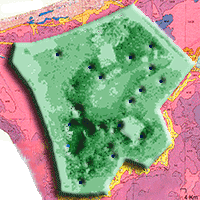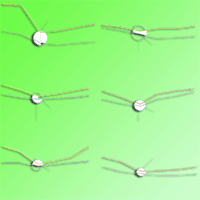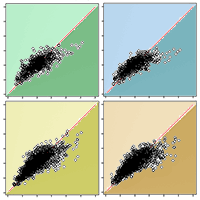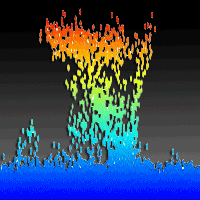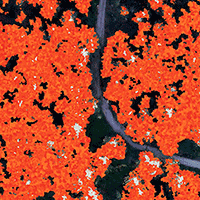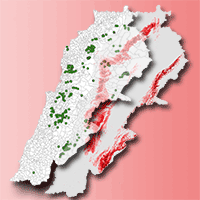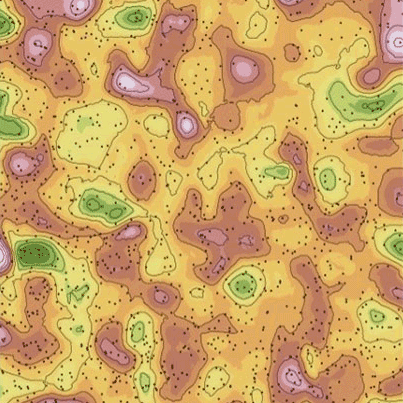Models of forest growth and yield provide important information on stand and tree developments and the interactions of these developments with silvicultural treatments. These models have been developed based on assumptions such as independence of observations, uncorrelated error terms, and error terms with constant variance; if these factors are absent, there may be problems with multicollinearity, autocorrelation, or heteroscedasticity, respectively. These problems, which have several adverse effects on parameter estimates, are statistical phenomena and must be avoided. In recent years, the artificial neural network (ANN) model, thanks to its superior features such as the ability to make successful predictions and the absence of the requirement for statistical assumptions, has been commonly used in forestry modeling. However, while goodness-of-fit measures were taken into consideration in the assessment of ANN models, the control of the biological characteristics of model predictions was ignored. In this study, variable-density yield models were developed using nonlinear regression and ANN techniques. These modeling techniques were compared based on some goodness-of-fit measures and the principles of forest yield. The results showed that ANN models were more successful in meeting expected biological patterns than regression models.
Keywords
, , ,
Citation
Bolat F, Ercanli I, Günlü A (2023). Yield of forests in Ankara Regional Directory of Forestry in Turkey: comparison of regression and artificial neural network models based on statistical and biological behaviors. iForest 16: 30-37. - doi: 10.3832/ifor4116-015
Academic Editor
Maurizio Marchi
Paper history
Received: Apr 14, 2022
Accepted: Nov 04, 2022
First online: Jan 22, 2023
Publication Date: Feb 28, 2023
Publication Time: 2.63 months
© SISEF - The Italian Society of Silviculture and Forest Ecology 2023
Open Access
This article is distributed under the terms of the Creative Commons Attribution-Non Commercial 4.0 International (https://creativecommons.org/licenses/by-nc/4.0/), which permits unrestricted use, distribution, and reproduction in any medium, provided you give appropriate credit to the original author(s) and the source, provide a link to the Creative Commons license, and indicate if changes were made.

Breakdown by View Type
(Waiting for server response...)
Article Usage
Total Article Views: 25063
(from publication date up to now)
Breakdown by View Type
HTML Page Views: 20725
Abstract Page Views: 2294
PDF Downloads: 1639
Citation/Reference Downloads: 0
XML Downloads: 405
Web Metrics
Days since publication: 1064
Overall contacts: 25063
Avg. contacts per week: 164.89
Article Citations
Article citations are based on data periodically collected from the Clarivate Web of Science web site
(last update: Mar 2025)
Total number of cites (since 2023): 6
Average cites per year: 2.00
Publication Metrics
by Dimensions ©
Articles citing this article
List of the papers citing this article based on CrossRef Cited-by.
(1)
Akilli A, Hülya A (2020)Evaluation of normalization techniques on neural networks for the prediction of 305-day milk yield. Turkish Journal of Agricultural Engineering Research 1: 354-367.
CrossRef |
Gscholar
(2)
Anonymous (2017)Ekosistem tabanli fonksiyonel orman amenajman planlarinin düzenlenmesine ait usul ve esaslar [Principles and procedures for the regulation of ecosystem-based functional forest management plans]. Orman ve Su Ä°ÅŸleri Bakanlığı, Orman Genel MüdürlüÄŸü, Orman Amenajmanı ve Planlama Dairesi BaÅŸkanliÄŸi, Ankara, Teblig 299: 214 [in Turkish]
Gscholar
(3)
Ashraf MI, Zhao Z, Bourque CP-A, MacLean DA, Meng F-R (2013)Integrating biophysical controls in forest growth and yield predictions with artificial intelligence technology. Canadian Journal of Forest Research 43: 1162-1171.
CrossRef |
Gscholar
(4)
Bolat F (2021)Ankara Orman Bölge MüdürlüÄŸü Anadolu karaçami meÅŸcerelerinde artım ve büyümenin yapay sinir aÄŸlari ile modellenmesi [Modeling forest growth and yield in Anatolian black pine stands located Ankara Forest District Directorate by artificial neural network]. PhD Thesis, Çankiri Karatekin Üniversitesi, Fen Bilimleri Enstitüsü, Turkey, pp. 213.
Gscholar
(5)
Burkhart HE, Tomé M (2012)Modeling forest trees and stands. Springer Science+Business Media, Dordrecht, Netherlands, pp. 458.
Online |
Gscholar
(6)
Castaño-Santamaría J, Crecente-Campo F, Fernández-Martínez JL, Barrio-Anta M, Obeso JR (2013)Tree height prediction approaches for uneven-aged beech forests in northwestern Spain. Forest Ecology and Management 307: 63-73.
CrossRef |
Gscholar
(7)
Che S, Tan X, Xiang C, Sun J, Hu X, Zhang X, Duan A, Zhang J (2019)Stand basal area modelling for Chinese fir plantations using an artificial neural network model. Journal of Forestry Research 30: 1641-1649.
CrossRef |
Gscholar
(8)
Chenge IB (2021)Height-diameter relationship of trees in Omo strict nature forest reserve, Nigeria. Trees, Forests and People 3 (2019): 100051.
CrossRef |
Gscholar
(9)
Curtis RO (1982)A simple index of stand density for Douglas-fir. Forest Science 28: 92-94.
Online |
Gscholar
(10)
Diamantopoulou MJ, Ozçelik R (2012)Evaluation of different modeling approaches for total tree-height estimation in Mediterranean region of Turkey. Forest Systems 21: 383-397.
CrossRef |
Gscholar
(11)
Dubey SR, Singh SK, Chaudhuri BB (2021)A comprehensive survey and performance analysis of activation functions in deep learning. ArXiv Preprint 2109: 14545.
CrossRef |
Gscholar
(12)
Fang Z, Bailey RL (2001)Nonlinear mixed effects modeling for slash pine dominant height growth following intensive silvicultural treatments. Forest Science 47: 287-300.
Online |
Gscholar
(13)
Fekedulegn D, Mac Siúrtáin MP, Colbert JJ (1999)Parameter estimation of nonlinear models in forestry. Silva Fennica 33: 327-336.
CrossRef |
Gscholar
(14)
Foody GM, Lucas RM, Curran PJ, Honzak M (1997)Mapping tropical forest fractional cover from coarse spatial resolution remote sensing imagery. Plant Ecology 131: 143-154.
CrossRef |
Gscholar
(15)
Foresee FD, Hagan MT (1997)Gauss-Newton approximation to Bayesian learning. In: Proceedings of “International Conference on Neural Networks (ICNN’97)”. Houston (TX, USA) 12 June 1997. IEEEXplore, pp. 1930-1935.
CrossRef |
Gscholar
(16)
Fortin M, Daigle G, Ung C-H, Bégin J, Archambault L (2007)A variance-covariance structure to take into account repeated measurements and heteroscedasticity in growth modeling. European Journal of Forest Research 126: 573-585.
CrossRef |
Gscholar
(17)
Fox JC, Ades PK, Bi H (2001)Stochastic structure and individual-tree growth models. Forest Ecology and Management 154: 261-276.
CrossRef |
Gscholar
(18)
GDF (2020)Forestry statistics in Turkey. Ministry of Agriculture and Forestry, General Directorate of Forestry, Forest Management and Planning Department, Ankara, Turkey. [In Turkish]
Online |
Gscholar
(19)
Gilabert H, Manning PJ, McDill ME, Sterner S (2010)Sawtimber yield tables for Pennsylvania forest management planning. Northern Journal of Applied Forestry 27: 140-150.
CrossRef |
Gscholar
(20)
Guan BT, Gertner GZ, Parysow P (1997)A framework for uncertainty assessment of mechanistic forest growth models: a neural network example. Ecological Modelling 98: 47-58.
CrossRef |
Gscholar
(21)
Hamidi SK, Weiskittel A, Bayat M, Fallah A (2021)Development of individual tree growth and yield model across multiple contrasting species using nonparametric and parametric methods in the Hyrcanian forests of northern Iran. European Journal of Forest Research 140: 421-434.
CrossRef |
Gscholar
(22)
Hirigoyen A, Navarro-Cerrillo R, Bagnara M, Franco J, Requin F, Rachid-Casnati C (2021)Modelling taper and stem volume considering stand density in
Eucalyptus grandis and
Eucalyptus dunnii. iForest - Biogeosciences and Forestry 14 (2): 127-136.
CrossRef |
Gscholar
(23)
Jensen JR, Qiu F, Ji M (1999)Predictive modelling of coniferous forest age using statistical and artificial neural network approaches applied to remote sensor data. International Journal of Remote Sensing 20: 2805-2822.
CrossRef |
Gscholar
(24)
Kalipsiz A (1963)Türkiye’de Karaçam mescerelerinin tabii bünyesi ve verim kudreti üzerine arastirmalar [Studies on the natural structure and yield potential of Black pine stands in Turkey]. Tarim Bakanligi/Orman Genel Müdürlügü, Istinbul, Turkey, vol. 8, pp. 138. [In Turkish]
Gscholar
(25)
Kanellopoulos I, Wilkinson GG, Megier J (1993)Integration of neural network and statistical image classification for land cover mapping. In: Proceedings of “IEEE International Geoscience and Remote Sensing Symposium - IGARSS ’93”. Tokyo (Japan) 18-21 Aug 1993. IEEEXplora, vol. 2, pp. 511-513.
CrossRef |
Gscholar
(26)
Karatepe Y, Diamantopoulou MJ, Ozçelik R, Sürücü Z (2022)Total tree height predictions via parametric and artificial neural network modeling approaches. iForest - Biogeosciences and Forestry 15 (2): 95-105.
CrossRef |
Gscholar
(27)
Lima MBO, Lustosa Junior IM, Oliveira EM, Ferreira JCB, Soares KL, Miguel EP (2017)Artificial neural networks in whole-stand level modeling of
Eucalyptus plants. African Journal of Agricultural Research 12: 535-541.
CrossRef |
Gscholar
(28)
Liu C, Zhang SY (2005)Models for predicting product recovery using selected tree characteristics of black spruce. Canadian Journal of Forest Research 35: 930-937.
CrossRef |
Gscholar
(29)
Maier HR, Dandy GC, Burch MD (1998)Use of artificial neural networks for modelling cyanobacteria
Anabaena spp. in the River Murray, South Australia. Ecological Modelling 105: 257-272.
CrossRef |
Gscholar
(30)
Maier HR, Dandy GC (2000)Neural networks for the prediction and forecasting of water resources variables: a review of modelling issues and applications. Environmental Modelling and Software 15: 101-124.
CrossRef |
Gscholar
(31)
MathWorks (2020)MATLAB User’s guide, Version 2020b. The MathWorks, Inc., Natick, MA, USA.
Gscholar
(32)
Meyer WH (1938)Yield of even-aged stands of Ponderosa pine. Technical Bulletin no. 630, USDA, Washington, DC, USA, pp. 60.
Online |
Gscholar
(33)
Ogana FN, Corral-Rivas S, Gorgoso-Varela JJ (2020)Nonlinear mixed-effect height-diameter model for
Pinus pinaster Ait. and
Pinus radiata D. Don. Cerne 26: 150-161.
CrossRef |
Gscholar
(34)
Okut H (2016)Bayesian regularized neural networks for small n big p data. In: “Artificial Neural Networks - Models and Applications”. Intech, London, UK, 28-48.
CrossRef |
Gscholar
(35)
Ozçelik R, Diamantopoulou MJ, Brooks JR, Wiant HV (2010)Estimating tree bole volume using artificial neural network models for four species in Turkey. Journal of Environmental Management 91: 742-753.
CrossRef |
Gscholar
(36)
Ozçelik R, Diamantopoulou MJ, Crecente-Campo F, Eler U (2013)Estimating Crimean juniper tree height using nonlinear regression and artificial neural network models. Forest Ecology and Management 306: 52-60.
CrossRef |
Gscholar
(37)
Ozçelik R, Diamantopoulou MJ, Brooks JR (2014)The use of tree crown variables in over-bark diameter and volume prediction models. iForest - Biogeosciences and Forestry 7 (3): 132-139.
CrossRef |
Gscholar
(38)
Raptis DI, Kazana V, Kazaklis A, Stamatiou C (2021)Mixed-effects height-diameter models for black pine (
Pinus nigra Arn.) forest management. Trees 35: 1167-1183.
CrossRef |
Gscholar
(39)
Seki M, Sakici OE (2022)Ecoregional variation of Crimean Pine (
Pinus nigra subspecies
pallasiana [Lamb.] Holmboe) stand growth. Forest Science 68 (5-6): 452-463.
CrossRef |
Gscholar
(40)
Skudnik M, Jevšenak J (2022)Artificial neural networks as an alternative method to nonlinear mixed-effects models for tree height predictions. Forest Ecology and Management 507 (1): 120017.
CrossRef |
Gscholar
(41)
Temesgen H, Zhang CH, Zhao XH (2014)Modelling tree height-diameter relationships in multi-species and multi-layered forests: a large observational study from Northeast China. Forest Ecology and Management 316: 78-89.
CrossRef |
Gscholar
(42)
TSMS (2022)Turkish State Meteorological Service. Web site.
Online |
Gscholar
(43)
Vanclay JK (1994)Modelling forest growth and yield: applications to mixed tropical forests. CAB International, Wallingford, UK, pp. 329.
Gscholar
(44)
Vanclay JK, Skovsgaard JP (1997)Evaluating forest growth models. Ecological Modelling 98: 1-12.
CrossRef |
Gscholar
(45)
Wang M, Borders BE, Zhao D (2008)An empirical comparison of two subject-specific approaches to dominant heights modeling: The dummy variable method and the mixed model method. Forest Ecology and Management 255: 2659-2669.
CrossRef |
Gscholar
(46)
Weiskittel AR, Hann DW, Jr JAK, Vanclay JK (2011)Forest growth and yield modeling. John Wiley and Sons, USA, pp. 431.
CrossRef |
Gscholar
(47)
West PW, Ratkowsky DA, Davis AW (1984)Problems of hypothesis testing of regressions with multiple measurements from individual sampling units. Forest Ecology and Management 7: 207-224.
CrossRef |
Gscholar
(48)
Zhang Q-B, Hebda RJ, Zhang Q-J, Alfaro RI (2000)Modeling tree-ring growth responses to climatic variables using artificial neural networks. Forest Science 46: 229-239.
Online |
Gscholar
(49)
Zuur AF, Ieno EN, Elphick CS (2010)A protocol for data exploration to avoid common statistical problems. Methods in Ecology and Evolution 1 (1): 3-14.
CrossRef |
Gscholar



